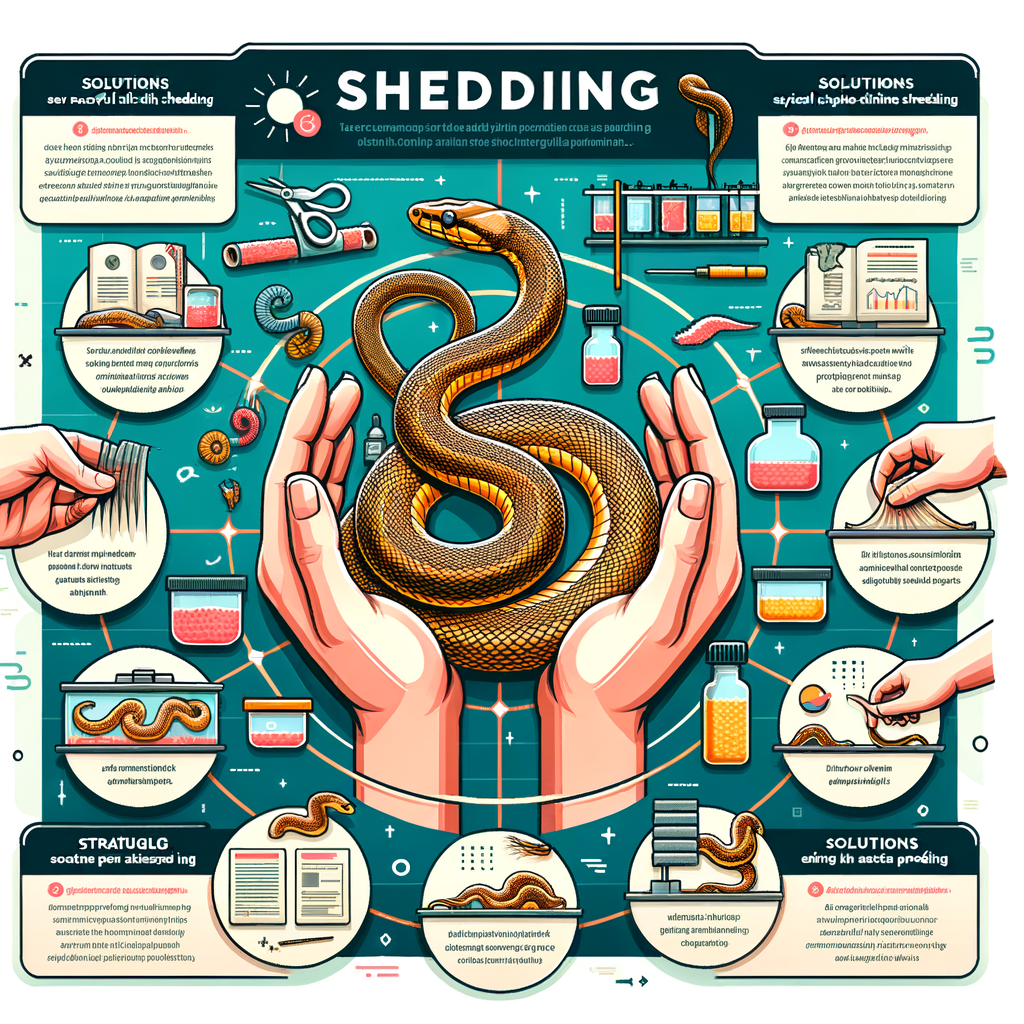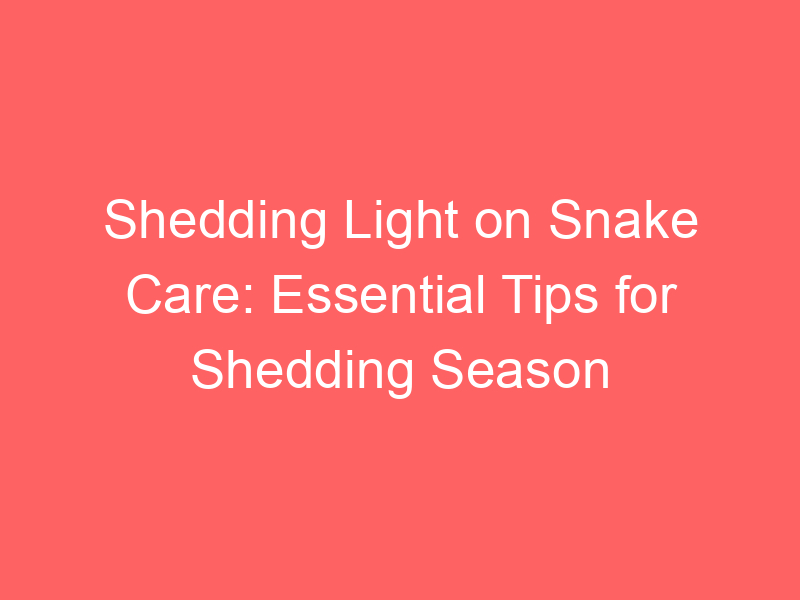
Introduction to Snake Shedding Process
Shedding, also known as ecdysis, is a natural process that snakes undergo throughout their lives. This fascinating process is not only essential for a snake’s growth and health, but it also provides us with a unique opportunity to learn more about these remarkable creatures.
- Understanding the snake shedding process
- Why is shedding important for snakes?
- Common snake shedding issues
Snakes shed their skin to allow for growth and to remove parasites that may have attached to their old skin. Unlike humans, who constantly shed skin cells, snakes do it all at once. This process starts when the snake’s skin begins to loosen. The snake will then rub its body against rough surfaces to peel off the old skin. If all goes well, the old skin will come off in one piece, like an inside-out sock.
Shedding is crucial for snakes for several reasons. Firstly, it allows snakes to grow. As snakes grow, their old skin becomes too tight and needs to be replaced with a new, larger one. Secondly, shedding helps snakes to stay healthy by removing parasites and dirt from their skin. Lastly, the process of shedding can also help to heal any minor wounds or injuries a snake may have.
While shedding is a natural process for snakes, it can sometimes lead to problems. One common issue is incomplete shedding, where parts of the old skin remain on the snake’s body. This can lead to infections and other health issues. Another common problem is dysecdysis, a condition where the snake has difficulty shedding its skin. This can be caused by a lack of humidity or other environmental factors.
Understanding the snake shedding process and its importance, as well as being aware of common shedding issues, is crucial for anyone who owns or cares for snakes. In the following sections, we will delve deeper into shedding techniques, case studies of successful snake shedding, and how to care for a shedding snake.
Shedding Techniques for Snakes
Snake shedding is a natural process that all snakes go through as they grow. It’s a fascinating process and understanding it can help you take better care of your pet snake. Let’s delve into the preparation phase of the shedding process.
Preparation for Shedding
Before a snake begins to shed its skin, there are a few crucial steps that need to be taken to ensure a successful shed. These steps involve providing the right environment and ensuring proper nutrition.
- Providing the Right Environment
- Ensuring Proper Nutrition
Creating a comfortable environment for your snake is essential for a successful shed. Snakes need a warm, humid environment to help loosen the old skin. This can be achieved by maintaining a temperature of around 80-85 degrees Fahrenheit and a humidity level of about 50-70%. You can also add a shedding box filled with damp moss to your snake’s enclosure to help increase humidity.
Nutrition plays a vital role in the shedding process. A well-fed snake will have an easier time shedding its skin. Make sure your snake is eating a balanced diet of appropriate prey. This will provide the necessary nutrients for a healthy shed. Remember, a snake that is not eating well may have difficulty shedding.
By taking these steps, you can help ensure your snake has a successful shed. In the next section, we will discuss what to do during the shedding process.
During the Shedding Process
Once your snake begins the shedding process, it’s crucial to pay close attention to their behavior and provide necessary aid. Here are some steps to follow:
- Monitoring your snake’s behavior
During the shedding process, snakes often exhibit changes in behavior. They may become more reclusive, lose their appetite, or even show signs of agitation. It’s important to monitor these changes closely, as they can provide valuable insights into your snake’s health and well-being.
For instance, if your snake is hiding more than usual, it might be because they’re feeling vulnerable during the shedding process. On the other hand, if your snake is rubbing against objects in their enclosure, it’s a sign that they’re trying to loosen their old skin.
Remember, each snake is unique, and their behavior can vary. The key is to know your snake’s normal behavior so you can spot any unusual changes.
- Providing aid for snake shedding
While snakes are generally capable of shedding on their own, there are times when they might need your help. Here are some ways you can aid your snake during the shedding process:
- Humidity: Maintaining the right level of humidity in your snake’s enclosure can help facilitate a successful shed. Too little humidity can lead to incomplete shedding, while too much can cause respiratory issues. Aim for a humidity level of around 50-70%, depending on the species of your snake.
- Bathing: If your snake is having trouble shedding, a warm bath can help. Fill a container with lukewarm water (not too hot, not too cold) and let your snake soak for about 15-20 minutes. This can help soften the old skin, making it easier for your snake to shed.
- Gentle Assistance: If your snake still has trouble shedding after a bath, you can gently assist them. Using a damp cloth, gently rub the area where the old skin is still attached. Be careful not to pull or force the skin off, as this can harm your snake.
Remember, always consult with a vet or a professional herpetologist if you’re unsure about how to assist your snake during the shedding process.
Successful Snake Shedding: Case Studies
Let’s delve into some real-life examples of successful snake shedding. These case studies will provide practical insights into how environmental changes and dietary adjustments can significantly improve the snake shedding process.
- Case Study 1: Improving Snake Shedding with Environmental Changes
In this case, a pet owner noticed that their Ball Python was having difficulty shedding. The skin was not coming off in one piece, and the snake seemed distressed. After researching, the owner discovered that the humidity level in the snake’s enclosure was too low. Snakes need a certain level of humidity for successful shedding.
So, the owner decided to increase the humidity level in the enclosure by adding a larger water bowl and misting the enclosure with water daily. After making these changes, the snake’s next shed was successful. The skin came off in one piece, and the snake seemed much more comfortable. This case shows how important the right environmental conditions are for snake shedding.
- Case Study 2: Overcoming Snake Shedding Issues with Dietary Adjustments
In another case, a Corn Snake was also having trouble shedding. The owner noticed that the snake’s skin was dry and flaky, and the snake was not eating well. After consulting with a vet, the owner learned that the snake’s diet was lacking in certain nutrients that are essential for healthy skin and successful shedding.
The vet recommended adding more variety to the snake’s diet, including different types of rodents and occasional servings of fish. The owner followed the vet’s advice, and the snake’s shedding improved significantly. The skin was no longer dry and flaky, and the snake started eating well again. This case illustrates how a balanced diet can solve shedding issues in snakes.
In conclusion, both environmental changes and dietary adjustments can play a crucial role in successful snake shedding. As snake owners, it’s important to pay attention to these factors to ensure our pets’ health and comfort.
Common Snake Shedding Issues and Solutions
Snakes, like all reptiles, go through a process called shedding where they remove their old skin. This process is usually smooth but sometimes, it can lead to certain issues. Let’s delve into some common problems and how to identify them.
Identifying Snake Shedding Issues
It’s important to keep a close eye on your snake during its shedding process. This way, you can spot any potential problems early on and take the necessary steps to resolve them.
- Signs of problematic shedding
- Patches of old skin remaining on the snake after shedding
- Cloudy or dull-looking eyes
- Lack of appetite
- Changes in behavior, such as increased aggression or hiding
- When to seek professional help
There are several signs that your snake might be having trouble with shedding. These include:
If you notice any of these signs, it’s crucial to take action quickly to help your snake.
While some shedding issues can be resolved at home, others require professional help. If your snake’s shedding problems persist despite your best efforts, or if your snake seems distressed or unwell, it’s time to consult a vet. A professional can provide the right treatment and advice to ensure your snake’s health and well-being.
Remember, shedding is a natural process for snakes and a little bit of attention can go a long way in ensuring it goes smoothly. Stay vigilant, know the signs of trouble, and don’t hesitate to seek professional help when needed.
Solutions for Snake Shedding Issues
When it comes to snake shedding issues, there are a variety of solutions that can help. These range from simple home remedies to professional treatments for more severe cases. Let’s delve into these solutions to help your snake have a successful shedding process.
- Home Remedies for Shedding Problems
- Humidity: One of the most common causes of shedding problems in snakes is low humidity. You can increase the humidity in your snake’s enclosure by adding a water dish or misting the enclosure with water.
- Bathing: Another effective home remedy is to give your snake a lukewarm bath. This can help to soften the old skin and make it easier for your snake to shed.
- Proper Diet: Ensuring that your snake has a proper diet can also help with shedding. A diet that is high in vitamins and minerals can promote healthy skin growth and shedding.
- Professional Treatments for Severe Shedding Issues
- Medical Treatments: These treatments can include medications to promote healthy skin growth, as well as treatments to address any underlying health issues that may be causing the shedding problems.
- Specialized Care: Professional treatments can also include specialized care, such as manual removal of the old skin or treatments to heal any wounds that may have occurred during the shedding process.
If your snake is having minor shedding issues, there are a few home remedies that can help. These remedies are easy to implement and can significantly improve the shedding process for your snake.
If your snake is experiencing severe shedding issues, it may be time to seek professional help. A professional herpetologist or veterinarian can provide treatments that are specifically designed to address shedding problems in snakes.
Remember, the key to successful snake shedding is to address any issues as soon as they arise. With the right care and attention, your snake can have a healthy and successful shedding process.
Snake Shedding Care: Key Takeaways
Understanding the process of snake shedding is crucial for any snake owner. It’s a natural process that all snakes go through and it’s our responsibility to ensure it goes smoothly. Here are the key takeaways from our discussion on snake shedding care:
- Importance of Regular Monitoring
- Role of Diet in Successful Snake Shedding
- Significance of Proper Habitat Conditions
Regular monitoring of your snake is essential. It helps you understand their shedding cycle and identify any potential issues early. For example, if your snake is having difficulty shedding, it may be due to a health issue or improper habitat conditions. Regular check-ups can help prevent these issues from escalating.
A snake’s diet plays a significant role in its shedding process. A well-balanced diet ensures that your snake has all the nutrients it needs for a successful shed. For instance, a diet rich in vitamins and minerals can help improve the health of your snake’s skin, making the shedding process easier.
Proper habitat conditions are vital for a successful snake shed. This includes maintaining the right temperature and humidity levels in the snake’s enclosure. These conditions help keep the snake’s skin moist, making it easier for them to shed. Additionally, providing your snake with plenty of hiding spots and rough surfaces can help facilitate the shedding process.
In conclusion, snake shedding care involves regular monitoring, a balanced diet, and proper habitat conditions. By paying attention to these key aspects, you can ensure your snake’s shedding process is successful and stress-free.
Conclusion: Ensuring Your Snake’s Shedding Success
As we wrap up our discussion on snake shedding, it’s important to remember that shedding is a natural process for snakes. It’s a sign of growth and good health. However, it can also be a stressful time for your pet. With the right knowledge and techniques, you can help your snake have a successful shedding process.
- Recap of shedding techniques for snakes
- Final thoughts on improving snake shedding
Throughout this article, we’ve discussed various techniques to ensure a successful shedding process for your snake. We’ve learned about the importance of maintaining the right humidity levels in your snake’s habitat. We’ve also talked about providing a rough surface for your snake to rub against to help remove the old skin. Additionally, we’ve highlighted the necessity of a good diet to ensure your snake’s overall health and successful shedding.
Improving your snake’s shedding process is all about understanding your snake’s needs and providing the right care. Remember, each snake is unique and may require different care techniques. Always observe your snake closely during the shedding process to identify any potential issues early. If you notice any problems, don’t hesitate to consult with a professional.
In conclusion, a successful shedding process is crucial for your snake’s health and well-being. By applying the techniques we’ve discussed, you can ensure your snake’s shedding success. Remember, the key to a healthy snake is a well-informed and caring owner.







